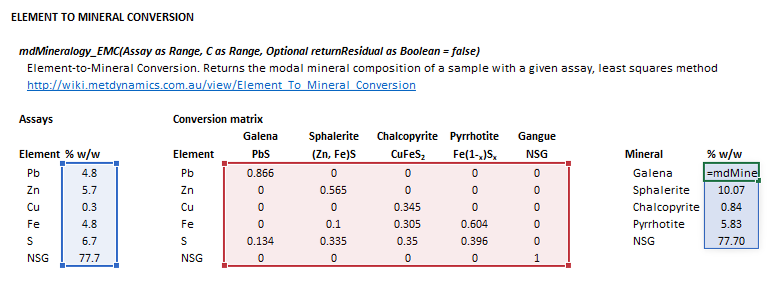Element To Mineral Conversion
Jump to navigation
Jump to search
Description
This article describes Whiten's (2007) method for converting elemental assays into mineral compositions.[1]
Model theory
Excel
The Element to Mineral Conversion may be invoked from the Excel formula bar with the following function call:
=mdMineralogy_EMC(Assay as Range, C as Range, Optional returnResidual as Boolean = false)
Invoking the function with no arguments will print Help text associated with the model, including a link to this page.
The input parameters and calculation results are defined below in matrix notation, along with an example image showing the selection of the same cells and arrays in the Excel interface:
|
| ||||
References
- ↑ Whiten, B., 2007. Calculation of mineral composition from chemical assays. Mineral Processing and Extractive Metallurgy Review, 29(2), pp.83-97.
![{\displaystyle {\begin{aligned}{\mathit {Assay}}&={\begin{bmatrix}a_{1}{\text{ (}}\%{\text{w/w)}}\\\vdots \\a_{n}{\text{ (}}\%{\text{w/w)}}\\\end{bmatrix}}\\\\{\mathit {C}}&={\begin{bmatrix}c_{11}{\text{ (w/w)}}&\cdots &c_{1p}{\text{ (w/w)}}\\\vdots &&\vdots \\c_{n1}{\text{ (w/w)}}&\cdots &c_{np}{\text{ (w/w)}}\\\end{bmatrix}}\\\\{\mathit {returnResidual}}&={\big [}{\text{(True/False)}}{\big ]}\\\end{aligned}}}](https://wikimedia.org/api/rest_v1/media/math/render/svg/492c708ecc14893d90981e9dfc18c2e77d61267b)









